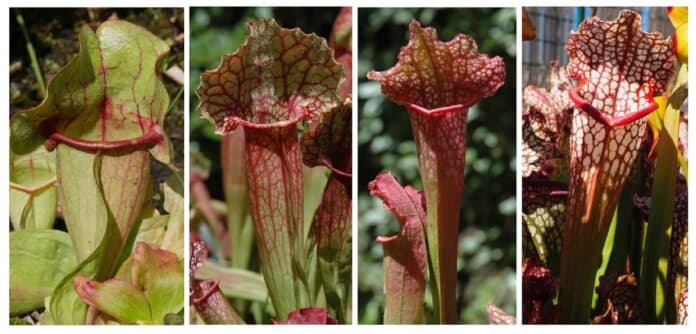A group of carnivorous plants, the so-called pitcher plants, includes the well-known Sarraceniaceae- famed for their range of shapes and colors to help trap prey. However, less is known about their scents.
A new study- published in PLoS ONE hypothesized that pitcher odors play a vital role in prey composition. A few old studies used tissue extraction to investigate the odor of pitcher plants. Still, this method also collected non-volatile compounds and couldn’t offer information on the composition of the emitted bouquet.
This recent study used the same method to compare metabolites among Sarraceniaceae species and investigated their scent profile. The role of pitcher scent in attracting insects has been put forward in Sarracenia flava and S. leucophylla, where a significant correlation between fly visits and VOC emission rates has been found.
Scientists demonstrated this experimentally via olfactometry on ants and fly in Nepenthes rafflesiana, confirming earlier hypotheses.
Scientists collected the odors of 39 pitchers on 16 different plants in 13 extraction sessions. Pitchers were selected at comparable stages. They analyzed the samples using a gas chromatograph coupled to a mass spectrometer and an Optima 5-MS capillary column.
22 pitchers out of the 39 analyzed for their scents were also analyzed for their prey contents and pitcher morphology. Volatile organic compounds (VOCs) similarity analyses revealed taxon specificities that mirrored those revealed by prey similarity analyses. S. X leucophylla stood out by being more specialized in flying insects like bees and moths and by releasing more monoterpenes known to attract flower visitors. S. X Juthatip soper trapped as many bees but fewer moths, sesquiterpenes contributing less to its scent.
Scientists noted, “Ants and Diptera were the main prey of the other two with fatty-acid-derivative-dominated scents.”
Dr. Laurence Gaume, a co-author of the study, says, “Our findings are important because they suggest that these carnivorous plants are not passive but can target their prey.”
“It offers potentially interesting avenues in the field of biological control, and one can imagine drawing inspiration from the olfactory cues of these pitcher plants to control plant pests, for example.”
“However, we remain cautious because our results are based on correlations. Even with strong correlations, further tests are necessary to investigate whether the different insect types are indeed attracted to particular scents.”
“The smell of Sarracenia pitcher plants is also not very strong, and it takes around two weeks before the smell is at its strongest. While the nuances of the scent might not be very clear from the human nose, they can be far clearer for the antennae of insects.”
According to the study, every pitcher emitted a scent resembling that of generalist plants that a wide variety of species can pollinate. The scientists observed that the pitchers exhibited slight variations in the VOCs they produced, even though this enabled them to spread their net widely for possible prey.
Pitchers attract bees and butterflies because they are enriched in limonene, which gives citrus fruits their characteristic aroma. It derives from a group of compounds that approximately two-thirds of flowering plants’ scent contain and that draw these pollinators.
In the meantime, S. purpurea possessed a smell rich in fatty acid compounds known to draw parasitoid wasps and insect predators. The animals made up a sizable portion of the plant’s nutrition, indicating that the aroma may be aimed explicitly toward them.
According to scientists, the odor of a pitcher and its dimensions can be used to predict the prey caught by a plant around 98% of the time. Further research could help to explain how carnivorous plants pollinated by insects can attract some species for pollination and others for food.
Journal Reference:
- Dupont C, Buatois B, Bessiere J-M, Villemant C, Hattermann T, Gomez D, et al. (2023). Volatile organic compounds influence prey composition in Sarracenia carnivorous plants. PLoS ONE 18(4): e0277603. DOI: 10.1371/journal.pone.0277603
